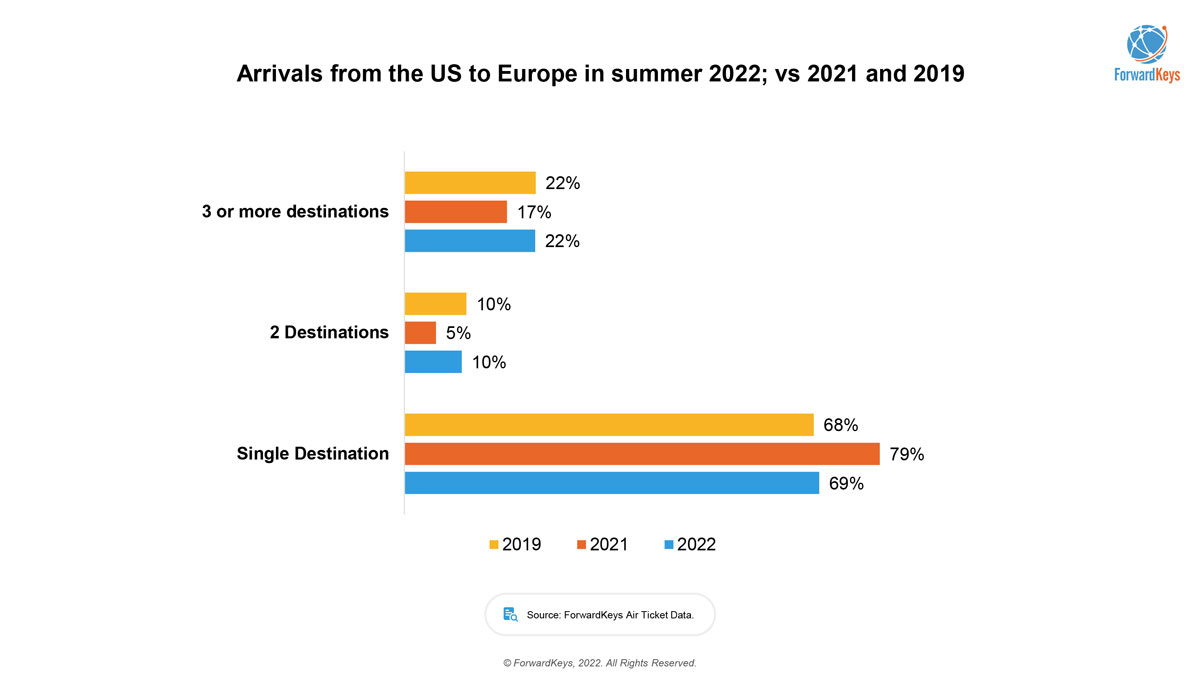
European travel retail stands to benefit from the return of affluent American travellers to the continent, while the recovery of multi-destination trips is another positive development for the sector.
NB: This is an article from ForwardKeys
The easing of entry requirements throughout Europe comes as a relief to the entire travel industry – not least the travel retail sector, which relies on the steady flow of wealthy travellers through airports. As a result of Europe’s reactivation, both intracontinental and long-haul inbound travel are recovering well.
Subscribe to our weekly newsletter and stay up to date
Of particular interest to duty-free operators and retail brands is the long-haul segment, which, according to our on-the-book data, will reach 2019 levels during the Christmas peak season.

Affluent tourists from the US top the ranking
Among the long-haul markets leading this recovery, the United States tops the table, having reached 95% of its 2019 performance and, based on on-the-book arrivals, will reach 96% in the autumn months. With the US historically representing an important market for travel retail, this is a further boost for Europe-based duty-free operators and airport retailers that have suffered during the pandemic.

In yet more good news for the European travel retail sector, US visitors to the continent are, on average, spending more on their overseas trips than before the pandemic. Compared to 2019, premium cabin class travel is up 18%, while economy is still down by 8%.

Multi-destination trips in Europe are back
Another noteworthy trend is the return of multi-destination trips to pre-pandemic levels. This summer, 32% of US arrivals in Europe visited two or more destinations, the same proportion as in 2019 and 10 percentage points greater than in 2021. This suggests that the fear of being caught out by changing travel restrictions is fading, and that Americans generally feel more confident about crossing multiple borders during their stay. It is also a positive development for travel retail as it allows airport stores in more European destinations to profit from this highly valuable source market.

The most frequently used hub airports in Europe
While the return of multi-trip destinations is a return to “normal” travel behaviour, the airports used to reach European destinations is not. The new Istanbul airport, which only opened a year before the start of the Covid-19 pandemic, benefits most from the return of American travellers with 76% more traffic than in 2019. It thereby starts to accomplish its promise of becoming a new duty-free shopping hub.
Other airports, some of which surprising, that have benefited from more passengers from the US passing through include Vienna, Montreal, and Reykjavik with all three comfortably surpassing their 2019 performance, at +65%, +65% and +38%, respectively.

What lies ahead?
For a sector that was hit harder than most by the Covid-19 pandemic and resulting travel restrictions, the return of affluent US travellers to Europe – and their propensity to visit more than one destination – is a hugely positive development. Even more encouragingly, the trend looks set to continue in the months ahead.
Still, as expected, the Covid-19 pandemic has lefts its dent on the industry. Many of the trends that we took for granted and which only slowly changed, have been affected. The different airport hubs used, and the increase in business class travellers are only a few of the big changes we have seen in our data.




